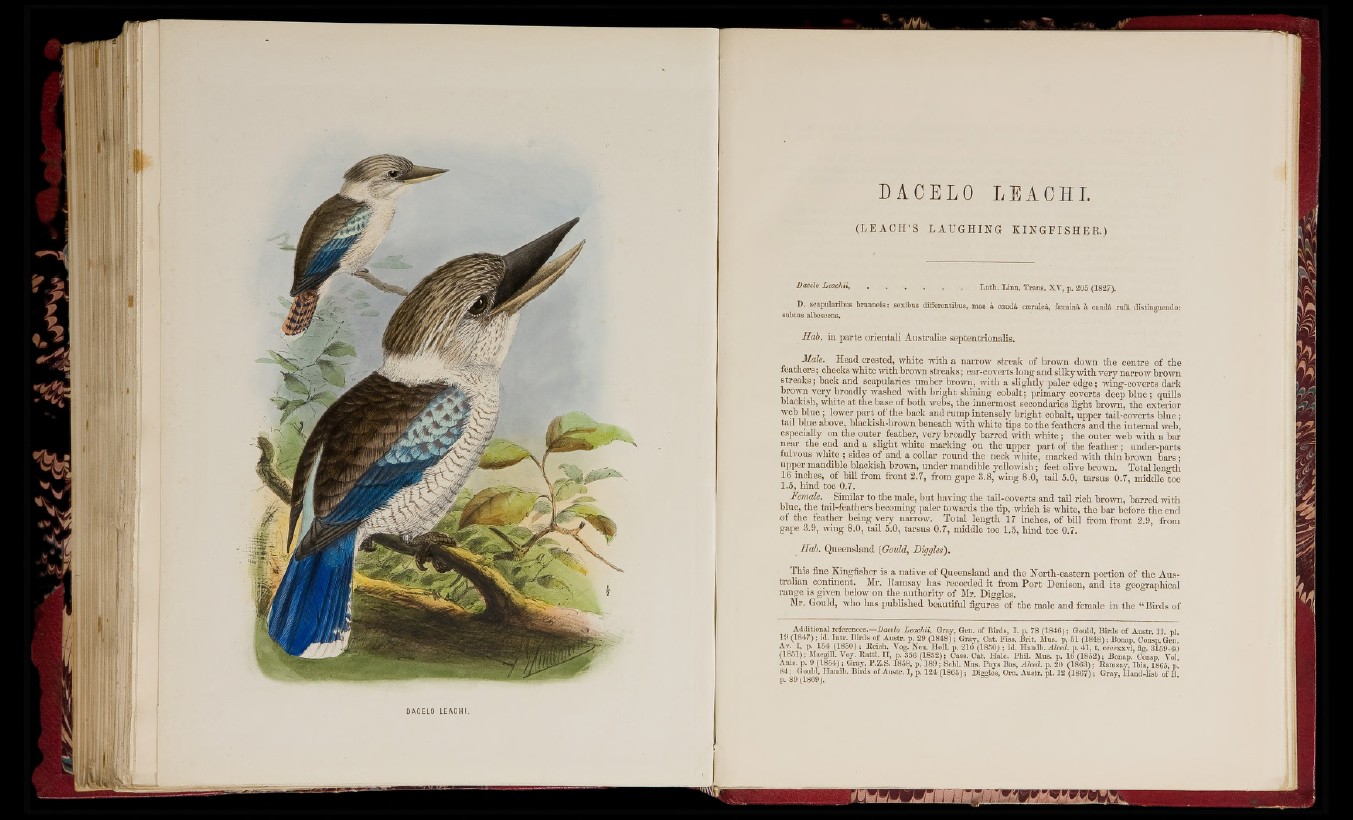
( t
' I f #
DACELO LEACHI.
DAOELO L E A C I I I
( L E A C H ’S L A U G H I N G K I N G F I S H E R . - )
Dacelo Leachii, Lath. Linn. Trans. XV, p. 205 (1827).
D. scapularibus brunneis: sexibus differentibus, mas à eaudâ cæruleâ, foeminâ à caudâ rufâ distinguendo:
subtus albescens.
Hah. : 1 parte orientali Australiæ septentrionalis.
Maie. H e a d c re s te d , w h ite Avith a uarroAV s tr e a k o f broAAUi doAvn th e c e n t r e o f th e
fe a th e r s ; c h e e k s w h i t e Avdth broAvn s tre a k s ; ear-coA^erts lo n g a n d s ilk y Avith A-ery narroAA" b row n
s t r e a k s ; b a c k a n d s c a p u la rie s um b e r b row n , Avith a s lig h tly p a le r e d g e ; wing-coA-erts d a r k
b row n v e r y b ro a d ly Avashcd -with b r ig h t s h in in g c o b a lt; p r im a r y c o v e rts d e e p b lu e ; q u ills
b la c k ish , Avhite a t th e b a s e oi b o th Avebs, th e in n e rm o s t secondai’ie s l ig h t b row n , th e e x te r io r
w e b b lu e ; low e r p a r t o f th e b a c k a n d r um p in te n s e ly b r ig h t c o b a lt, u p p e r ta il-c o v e rts b lu e ;
t a i l b lu e ab o v e , b la c k ish -b row n b e n e a th w ith w h ite tip s to th e fe a th e r s a n d th e in t e r n a l w e b ,
e sp e c ia lly o n tb e o u t e r fe a th e r , v e r y b ro a d ly b a r r e d w ith wKite ; tb e o u t e r w e b w i th a bai-
n e a r th e e n d a n d a s lig h t w h ite m a rk in g o n th e u p p e r p a r t o f th e fe a th e r ; u n d e r -p a r ts
iu lv o u s w h ite ; sides o f a n d a c o lla r r o u n d th e n e c k w h ite , m a rk e d w i th th in b row n b ai’s ;
u p p e r m a n d ib le b la c k is h b row n , u n d e r m a n d ib le y e llow ish ; fe e t o liv e b row n . T o ta l l e n r t h
16 in c h e s, o f b ill foo-m f r o n t 5 .7. fonm o-nno from 2 .7 ,from g a p e 3A .88 , wa fofT a n +«;! k o o 1
1 .5, h in d to e 0 .7 .
iemale. Similar to th e m ale, b u t having the tail-coverts and tail rich brown, b arred with
blue, the tail-featbei-8 becoming paler towards the tip, which is white, the b a r before th e end
o f the feather being very narrow. Total len g th 17 inches, o f bill from fro n t 2 .9 , from
gape 3 .9 , tving 8 .0 , tail 6 .0 , tarsu s 0 .7 , middle toe l.,5, hin d toe 0.7.
Hah. Queensland {Gould, Diggles).
This fine Kingfisher is a n ativ e o f Q ueensland and th e North-eastern portion o f the Aus-
tra lian continent. Mr. Ramsay has recorded i t from P o r t Denison, and its geooi-aphical
range is given beloAv on the au th o rity of Mr. Diggles.
Mr. Gould, who has published beautiful figures o f the male and female in th e “ Birds of
Additional references— Dacelo Leachii, Gray, Gen. of Birds, I. p. 78 (1846); Gould, Birds of Austr. I I pl
19 (1847) ; id. Intr. Birds of Austr. p. 29 (1848) ; Gray, Cat. Fiss. Brit. Mus. p, 51 (1848) ; Bonap. Consp. Gen
Av. I, p. 154 (1850) ; Reich. Vog. Neu. Holl. p. 210 (1850) ; id. Kundb. Alced. p. 41, t. ceccxxvi, fig. 8159-C(
(1851);Macgill. Atey. Ratti. II, p. 356(1852); Cass. Cat. Halc. Phil. Mus. p. 16 (1852); Bonap. Consp. Vol
Ams. p. 9 (1854) ; Gray, P.Z.S. 1858, p. 189 ; Schl. Mus. Pays Bas, Alced. p. 20 (1863) ; Ramsay, Ibis, 1865. p
84; Could, Handb. Birds ofAustr. I, p. 124(1865); Diggles, Orn. Austr. pl. 12 (1867) ; Gray, Hand-Hst ofB